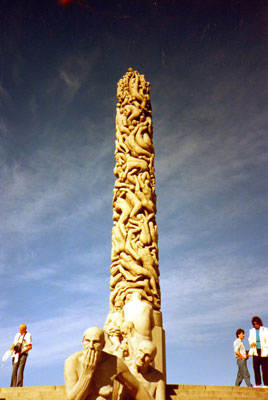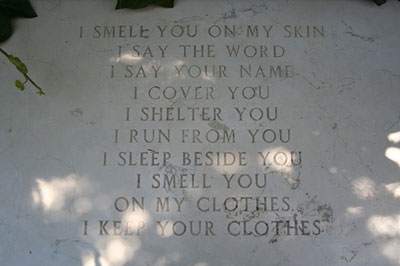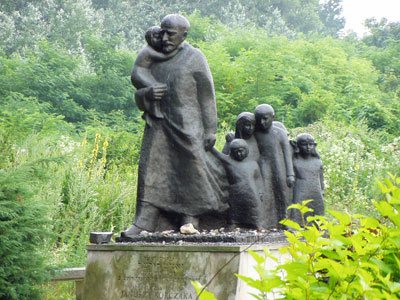Captivating art
In the course of your travels, what work of art took you by surprise in that it affected you deeply in some way? Which one lingered in your memory for some reason or made you long to see it again? We printed responses to those questions last month and show a few more below.
If you were moved by a painting, sculpture or other visual work of an artist (excluding great architecture — no buildings, themselves), write to Captivating Art, c/o ITN, 2116 28th St., Sacramento, CA 95818, or e-mail editor@intltravelnews.com. (Include the address at which you receive ITN.) The piece doesn’t have to be something famous, but you do need to be able to state what it was (either a title or an adequate description), where you saw it (so others may find it) and approximately when you viewed the work. Name the artist, if possible. Then describe the item or artwork and try to tell what it was about it that struck you plus the impression that it left.
Our month-long tour of Scandinavia put us in OSLO, Norway, for several sunny days in 1972. We walked everywhere and came across Vigeland Sculpture Park quite by accident. With its main entrance off the Kirkeveien, this park is inside the larger Frogner Park.
The park contains more than 200 works in Norwegian granite — depicting men, women and children — plus bas-reliefs and statues in bronze, all designed by Gustav Vigeland (1869-1943). The unique wrought-iron gates at the entrance were also designed by him.
Close by, the Vigeland Museum (Nobles gate 32, N-0268, Oslo, Norway; phone +47 23 49 37 00) gives a broad overview of Vigeland’s works.
In 1921 the City of Oslo entered into an agreement with the artist. Vigeland would be provided with a studio, which would become a museum after his death, and he could design his one-man sculpture park totally as he saw fit. Did Oslo ever get a bargain!
This great park and all his works are Vigeland’s monument. It has been almost 40 years since we saw the park, but we have never forgotten the power of his sculptures.
Richard Lynam
Vancouver, WA
In July of 1987 we were on a Royal Odyssey cruise that stopped in OSLO. We had ended a shore tour and it was suggested that we walk through a park. The park was Frogner Park, which has the Vigeland Sculpture Park in it.
Gustav Vigeland, a Norwegian sculptor, developed this sculpture park, which was begun in 1939 and completed, after his death, in 1949. It blew us away and we still talk about it.
There are more than 200 life-size sculptures in stone and bronze — men, women and children in various groupings and stages of age — and several wrought-iron gates. The sculpture “Wheel of Life” shows man’s journey from birth to death and symbolizes the theme of this park.
Attached to the park is the Vigeland Museum.
The strange thing is I had never heard of this park, and only my Norwegian friends seem to know about it.
Phyllis Mueller
San Jose, CA
After taking a class in German paintings of the era 1350-1530, I looked for Stefan Lochner’s “Madonna of the Rose Bower” in the Wallraf-Richartz Museum (Obenmarspforten, D-50667 Köln, Germany; phone +49 [0] 221 221 21119) when I visited COLOGNE in September ‘09.
It is a small picture, for private meditation. A sweet-faced Virgin Mary holds the baby Jesus. Mary and the baby are surrounded by a rose arbor, and angels offer them roses and apples. The roses likely allude to love and to Mary as a “rose without thorns.”
A quartet of angels at Mary’s feet is playing musical instruments. In the top corners, two angels pull the curtains back from the surrounding golden sky, temporarily revealing the vision below. God the Father looks over the garden, and the Holy Spirit hovers below Him.
When I look at this painting, I simply stop, and a feeling of deep peacefulness comes over me. I want to enter the garden to absorb Mary’s serenity and innocence. I want to abandon my cynicism and believe that salvation is possible.
Mary Rowin
Middleton, WI
In 1995, 1998, 2000 and 2002 we were fortunate to rent a spacious and beautiful house in a small town in Italy, Lisciano Niccone, which sits on the border between Tuscany and Umbria. Most of our visitors wanted to visit CORTONA, so we made frequent trips, about 30 minutes by car, to see the sights, enjoy the food and, of course, shop.
One of our regular stops was the Museo Diocesano (Piazza del Duomo 1, Cortona, Italy; phone 0575 62830), a small gem of a museum with world-class, priceless artworks. My favorite was “The Annunciation” by Fra Angelico, locally referred to as “The Pink Angel.”
I purchased a poster of the fresco while there and had it framed, and now it is hanging in my home in Naples.
Jeanine Healey
Naples, FL
I first encountered Jenny Holzer’s art on a bench in the sculpture garden at the Peggy Guggenheim Collection (Palazzo Venier dei Leoni, Dorsoduro 701,Venezia, Italy; phone +39 041 2405 411). It is one of our very favorite places, and we never visit VENICE without spending hours at the Guggenheim.
Engraved with a poem, Holzer’s “Garden Bench” is a long rectangle with words spread across in sections.
I love Holzer’s poem, which begins, “I walk in/I see you/I watch you/I scan you/I wait for you/
I tickle you/I tease you/I search you/I breath you…”
Marsha Caplan
Boulder, CO
My favorite artwork is the “Four Seasons” series (“Spring,” “Summer,” “Autumn” and “Winter”) by Giuseppe Arcimboldo, done in 1573. I’ve seen the paintings about 12 times in the Musée National du Louvre* in PARIS, France, the last time in 2009.
The four oil-on-canvas paintings, each 74cm x 64cm, depict heads in profile. In “Spring,” the head is composed all of flowers, “Summer” uses fruits and vegetables, “Autumn” is a head formed by an arrangement of autumn produce and the “Winter” head is depicted by tree stumps, bark and ivy.
The paintings were set together, two above and two below, and the order of the “Four Seasons” is full of symbolical symmetry. They are unique, unusual, and that is why I love them!
Pamela Lehmann
(city withheld per request)
*At press time, according to the Louvre’s website (www.louvre.fr), the paintings were still in the museum’s possession but were not on display.
We visited a great little museum in ZAGREB in October ’08 while on a Grand Circle Travel trip. The Croatian Museum of Naïve Art (Sv. Cirila i Metoda 3, Gornji grad, 10000 Zagreb, Croatia; phone +385 1 4851911) was close to our Westin Hotel.
I particularly liked the paintings by Ivan Laković Croata. Painted in oil on glass, they were colorful, delicate and captivating. This museum was well worth a visit.
Ellen L. Spaulding
Andover, KS
In April ’11 I traveled to DUNHUANG, located in northwest China and a two-hour flight from Xi’an, to visit the nearby Mogao Caves. In the grottoes are some of the best-preserved Buddhist statuary and frescoes in all of China. There is a total of 492 temples in the caves, but our tour covered just 10 caves.
The reason I liked the caves — they’re unique and so magnificent and well maintained.
Nancy Hesselbrock
Cincinnati, OH
There is no question; my very favorite work of “captivating art” is in the Cornaro Chapel in the Church of Santa Maria della Vittoria (Via XX Settembre 17, ROME, 187, Italy; phone 06 427 40571). Bernini carved “The Ecstasy of Saint Teresa” within the chapel, and it absolutely leaves one breathless.
You see the saint in glorious happiness while an angel is puncturing her breast with a gold arrow. She is over 11 feet tall and very imposing. On the side walls, you see the Cornaro family members leaning out of their box seats and observing the scene.
My husband and I made the discovery when we took some art history classes from a wonderful teacher. Whenever we are in Rome, we never fail to run to Santa Maria della Vittoria that morning to see our very favorite artwork. I guess it has been about five years since I last saw her.
• Going anywhere in the world to view a Caravaggio painting is also a life passion, thanks to our art history teacher. I spent a week in Florence, Italy, in April ’11 searching for every Caravaggio painting that I could find. One time I went to Naples, Italy, for three days just to see a Caravaggio exhibit.
Diane Vigilante
Fair Haven, NJ
Before I traveled to ROME in October ’06, I always thought of Rome as being Michelangelo’s city, artistically, because of the Sistine Chapel and St. Peter’s Dome, among other attractions. Once I went there, however, I felt that Rome really belonged to Bernini, with his works of art spread out all over the city.
The one masterpiece of his that totally awed me was in the Borghese Gallery at the Villa Borghese Museum & Galleries (Piazzale del Museo Borghese 5, 00197 Rome, Italy; phone 0039 06 8413979).
The sculpture is called “Aeneas, Anchises and Ascanius.” It portrays Aeneas carrying his elderly father, Anchises, on his shoulders with his young son, Ascanius, following behind as they flee from the burning city of Troy.
The amazing way Bernini worked the marble — showing the muscles and veins of Aeneas, as he struggles to carry his father, versus the sagging flesh of his elderly father as well as the emotions playing out on their faces — totally impressed me. The marble seemed to be as pliant as skin rather than stone.
Ever since then, I always mentally compare any sculpture I view to this masterpiece to see how it measures up.
William Schmidt
Clinton Township, MI
I have seen some magnificent art in the course of my travels, and that is why the call for captivating art made me think. I can’t pick one piece of art. I can’t do it.
• I could not walk past without giving a nod to the cenotaph of a doctor, author, humanitarian, head of an orphanage and hero, Janusz Korczak. Found in the Jewish Cemetery in WARSAW, Poland, the memorial was created by Mieczyslaw Smorczewski and depicts Korczak carrying one child and being followed by others, all victims of WWII. I felt honored to be there.
• I would have to pull myself away from the “Psyché Ranimée par le baiser de l’Amour,” better known to English speakers as “Psyche Revived by Cupid’s Kiss,” by Antonio Canova. It looks so much more like it sounds in French: soft and beautiful. It’s at the Louvre in PARIS — the winged angel Cupid locked in an embrace with the swooning Psyche, lips about to touch in a romantic kiss.
• I think the most magnificent piece of art I have ever seen is in ROME. It’s Gian Lorenzo Bernini’s sculpture of “Apollo and Daphne” in the museum at the Villa Borghese Museum & Galleries.
I was there in 2005. Reservations were required for admission, so I asked the owner of the hotel where I was staying to help with the arrangements.
Bernini started the sculpture in 1622 at the age of 24 and worked on it for three years. Three years! That, alone, is amazing, to me.
I arrived at the Villa Borghese in summer, with time to enjoy the outside gardens. The estate was huge and there were many galleries of art. Even among such beauty, I was struck with awe when I came upon Apollo and Daphne.
In the story from ancient Greek mythology, Eros shot handsome Apollo with the arrow of love and beautiful Daphne with the arrow of hatred. Daphne was so repulsed by Apollo’s advances that when she realized he was in reach of her, she begged her father for help.
In soft marble, Bernini captured the moment when Apollo reached and grabbed Daphne’s curvaceous body and when her fingers and hands began to transform into branches, twigs and leaves, which, to my eye, seemed to shimmer in the wind. Bark had already engulfed her feet, legs and hips. I think I might have seen her turn into a laurel tree right before my eyes. Magnifico!
I would love to see Apollo and Daphne again.
Nancy Hendrickson
Washington Crossing, PA
As guests are encouraged to “hurry along,” two trips to the Villa Borghese in ROME (June ’98 and January ’99) were not nearly enough to study the Gian Lorenzo Bernini sculpture of “Apollo and Daphne,” which has always been housed in this magnificent mansion that belonged to Cardinal Borghese. This life-size work shows the chaste nymph Daphne trying to escape from Apollo, god of light.
He has failed to catch her in time, and she is in the process of turning into a laurel tree. Her feet have begun turning into the trunk and her fingers into the leafy branches. Her distress is so visible, it makes you ache for her.
Mildred Hill
Chesterfield, MO



